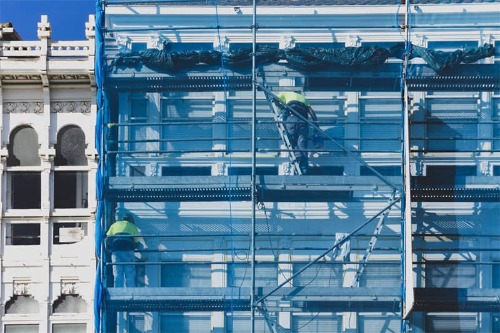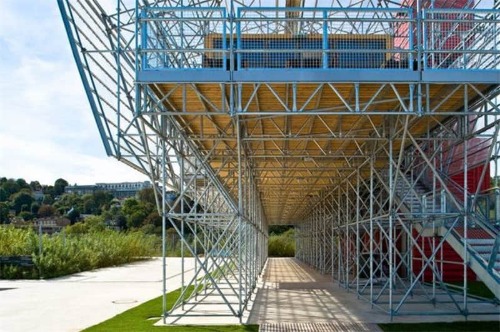Cuplock scaffolding is a versatile steel scaffolding system suitable for all types of access, support, and vertical support applications. Unlike ringlock scaffolding, which requires fixed metal brackets to be welded, cuplock scaffolding differs in that the four basic elements can be connected by striking the nodes in one motion, allowing it to be used for a wider range of applications. On all standard racks, the nodes are spaced 500 millimeters apart to ensure the correct working height and the correct height of handrails. Because the four sections are fixed in one go, the system can be installed much faster than traditional methods.
Cuplock Scaffolding Components
As a cuplock scaffolding manufacturers with more than 20 years of export experience, we are able to provide you with various types of scaffolding accessories
Advantages Of Cup Lock Scaffolding
- Quick Assembly: Cuplock scaffolding sets up fast due to its snap-on components, saving time and labor.
- Strong: Cuplock scaffolding supports heavy loads, ensuring stability and safety.
- Adaptable: It adjusts to different structures, even complex ones.
- Fewer Parts: With fewer components, assembly is straightforward.
- Cost-Effective: Despite initial costs, it saves money in the long run due to efficiency.
Customize Your Cuplock Scaffolding
Surface Technology

- Painting: The most common way for providing paint, or any other protective coating, to the surface of scaffolding for protection from the effects of the external environment, and for aesthetic purposes.
- Hot Dip Galvanizing: The process in which the surface of the scaffold is coated with zinc to prevent corrosion. As such, it is useful to be familiar with two important facts related to the process; a process known as hot dip galvanizing, and another process electric galvanizing. In hot dip galvanizing, the scaffold passes through a bath of molten zinc. In electric or electro galvanizing, the surface of the scaffold is electrochemically protected with a layer of zinc.
- Powder coating: The method by which powdered paint is electrostatically charged and sprayed on to the scaffold. After it is sprayed, the assembly is baked at high temperatures to cure and bond the paint. The result is a uniform, durable, high-quality, and attractive finish. This is an environmentally friendly method of paint application, as it produces fewer emissions than liquid coatings, and all waste can be captured and safely disposed of.
- Electric galvanizing: The process of forming a thin coating of zinc on a scaffold's surface by the transfer of zinc ions through an electrolytic solution. This process creates a thinner coating than hot galvanizing, but on the other hand, it is relatively cheaper and quicker.
Size
- Platform Size: Adjust the scaffolding size to fit your project's space.
- Height: Customize the scaffolding's height for different construction levels.
- Weight Capacity: Make scaffolding stronger for heavier loads.
- Branding and Color: Add your logo or choose custom colors.
3D Model Display
AJ Building's professional designers can design a complete 3D model of cuplock scaffolding for you to help you better carry out your engineering project!
Complete Guide To Cuplock Scaffolding
Get To Know Cuplock Scaffolding
Cuplock scaffolding is defined by its unique locking mechanism. Unlike traditional scaffolding that relies on bolts and nuts for assembly, cuplock scaffolding uses a 'cuplock' system. This system consists of a series of top and bottom cups that lock scaffolding components together. The bottom cups are welded to the vertical standards at pre-defined intervals, and the top cups, which are movable, lock down onto the ledgers, transoms, or braces that are slotted into the bottom cups, securing them in place with a simple hammering action.
Popular Scaffolding Systems:
- Ringlock Scaffolding System
- Frame Scaffolding System
- Kwikstage System Scaffold
- Quick Lock Scaffold System
- Steel Prop System
Components Of Cuplock Scaffolding
Standards (Vertical Components): Standards serve as the backbones in the cuplock system. Designed as vertical tubes, the standards act as the primary means of support for the entire system. They are fixed with lower cups spaced in a uniform pattern, while a top cup can be rotated to secure or release the components.
Ledgers (Horizontal Components): Ledgers are designed as horizontal tubes that are connected to the standards. The main function of ledgers is to provide transverse support. As with the standards, the ledgers are also affixed to the cuplock system at every node. The point of contact is then secured via the casting of the top cups.
Transoms (Load-Bearing Components): Transoms are placed at right angles to the ledgers. They are used to hold scaffold boards in order to support the vertical scaffold pole. Scaffold boards are also used to support workers and their materials. Transoms are used to distribute the stated weight evenly through the entire structure.
Cuplock Nodes (Locking Mechanisms): These nodes are basically interlocking nodes. Simply speaking, this is the core of a cuplock system. These nodes are designed to include a fixed bottom cup and a movable top cup. It is due to this movable top cup that the ledgers and transoms can be locked and unlocked with ease. It is also the reason why cuplock system scaffolding is so effective.
Additional Accessories
Standard Sizes For Cuplock Scaffolding
Standards - The vertical tube or pipes are known as standards in scaffolding and it is the primary component of Cuplock system. The standards are manufactured in different lengths most commonly 3m, 2.5m, 2.0m, 1.5m. The lengths of these standards can be adjusted as per the need of the project. Generally, the spacing between each standard is maintained at 2.5m or 3m.
Ledgers - The horizontal component between the standards are known as Ledgers. The length of the ledgers is commonly manufactured in 2.5m, 1.8m, 1.2m and 900mm. The length of the ledger can be adjusted as per the need because depending upon the project.
Transoms - These are the load bearing component of the scaffolding which supports the working platforms, its length is different from the ledger. The most common types of Transom are of length 1.2m and 1.8m. Here the length of the Transom is only dependent on the Width of the board or the load which is being carried by the transom.
The Load-Bearing Capacity of Cuplock Scaffolding
Light-Duty (Class 3): These are capable of supporting up to 225 kg/m². They are best for light construction and maintenance tasks.
Medium-Duty (Class 2): These are capable of supporting up to 450 kg/m². They are suitable for most construction tasks, including residential and commercial buildings.
Heavy-Duty (Class 1): These are capable of supporting up to 675 kg/m² or more, and are meant for heavy construction work, including industrial projects and the construction of bridges.
Assembly Of Cuplock Scaffolding
- Arrange the ledger and transoms in their estimated spots for the initial bay. Proceed to insert an adjustable base jack into each of the first pair of standards.
- Join the standards and transom at the bottom cup joint by aligning the blades with the cups. Ensure the transom is leveled. Begin the scaffold with a three-meter standard on the outer side and a two-meter standard on the inner side.
- Repeat the above steps and learn through the following videos:
Cuplock Scaffolding Practical Applications
In construction, maintenance, and renovation projects, scaffold systems serve a multitude of practical purposes. They not only provide a reliable means for workers to perform tasks at elevated heights, but they also provide an anchoring location for workers to stage materials and tools. Scaffolding systems are employed in a variety of scenarios including:
- Construction and Building New Construction: Building high-rise facilities or structures requires the use of scaffolding to enable workers to work at different heights. Bricklaying, painting, window installation, and related tasks are some examples.

- Exterior Work: Scaffolding is critical to exterior work. It includes exterior wall insulation, exterior finishing, and wall painting.

- Maintenance and Renovation Building Maintenance: The maintenance and renewal of buildings can also be performed on the exterior or interior of the buildings. Some examples of building maintenance include small jobs on high ceilings that would need light fixtures to be installed or replaced.

- Special Projects Events and Exhibitions: To build stage structures, stands, and create temporary structures required for various events, scaffolding is used.

- Bridge and Large Structure Maintenance: Scaffolding is necessary for the maintenance and renovation of mega structures like bridges, dams, and other major monuments.

Cuplock Scaffolding Package

Why Choose AJ Building For Your Scaffolding Requirements?
- Global Export Expertise: With a focus on scaffolding export, we have built a strong network for logistics and supply which can ensure timely and efficient delivery to any part of the world. Our team is very well versed in international trade applications and requirements, making your export journey smooth.
- Quality without Compromise: We ensure that only high-quality raw materials are used, all our products pass the stringent quality control checks before leaving our storehouse. Safety and customer satisfaction are core principles of our production and delivery process. With Wholesale Price.
- Bespoke Systems: We only offer bespoke scaffolding systems that are tailored to meet your exact project requirements. No matter where you are, our solutions will always be just the right fit.
- Customer Focused: We are proud of our customer relationships and we are desperately keen to ensure our customers are happy. Our export team lead from drawing board to final follow up of delivery and we are always available to answer any questions.
Our Promises to You
As a world-class exporter in the scaffolding industry, our mission is not to deliver, but to overdeliver. We only succeed when we can effectively improve the safety and productivity of your construction, maintenance, or event work through our highest-quality scaffolding structures.
Let's work together
AJ Building is dealing with innovative scaffolding solutions you'll love to have on your next project. We're standing by to assist you with expert product selection, consulting assistance, and superior customer service. You can trust us to handle your scaffolding needs with absolute precision and dedication to quality and safety.
Contact us to learn more about our product offering and how we can meet your scaffolding requirements.
FAQ
Is Cuplock scaffolding safe to use?
- Yes, Cuplock scaffolding is designed with safety in mind. It includes features such as guardrails, toe boards, and non-slip surfaces to protect workers.
What are the load-bearing capabilities of Cuplock scaffolding?
- Load-bearing capacity varies depending on the system's design and specifications. Generally, Cuplock scaffolding is known for its strength and ability to support heavy loads.
Is Cuplock scaffolding suitable for both indoor and outdoor projects?
- Yes, Cuplock scaffolding is versatile and can be used in various environments. Galvanized versions are often used outdoors for corrosion resistance.

 en
en fr
fr es
es

























